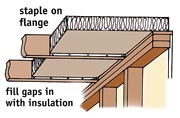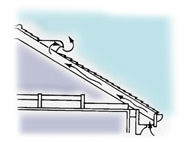
 Always apply blanket-type insulation with the vapor barrier facing the interior of your home. The vapor barrier should always be toward the source of heat in the winter (see image). Never place a vapor barrier between two layers of insulation. This can lead to a condensation problem and reduce the effectiveness of the insulation. Lay the blanket as close to the joists and floor as possible. Fill any gaps with loose-fill insulation or place another layer of blanket insulation across the previous layer.
Always apply blanket-type insulation with the vapor barrier facing the interior of your home. The vapor barrier should always be toward the source of heat in the winter (see image). Never place a vapor barrier between two layers of insulation. This can lead to a condensation problem and reduce the effectiveness of the insulation. Lay the blanket as close to the joists and floor as possible. Fill any gaps with loose-fill insulation or place another layer of blanket insulation across the previous layer.
Always place insulation on the outside of pipes or ducts (see image). This means the insulation should be between the outside wall and the pipes.
When using blanket insulation, always place the vapor barrier toward the heat source and insulation outside of any pipes.
Staple blanket insulation when laid between joists in the attic (see image). Most rolls of blanket insulation materials have flanges that can be stapled or tacked to the ceiling joists, as illustrated. Always keep the blanket as close to the joists and floor area as possible-fill any gaps with strips of insulation or loose-fill insulation.
Never allow blanket-type insulation to cut off the flow of air and stop proper ventilation in an attic (see image below). Blanket insulation should never block the air movement from the eave vents into the attic.

Proper ventilation in the attic is very important in any insulation job. Make provision for air to flow in and around the eave vents and to flow out through a ridge vent roof ventilator or through a ventilator on the end of the house (see first image below).
Blanket insulation without a vapor barrier can be wedged between existing ceiling joists (see second image below). Make sure the insulation comes to the top of the plate to avoid heat loss from the penetration of wind under the insulation. Failure to pay close attention to this detail can lead to a frost line forming on cold, windy days. It will form on the inside wall where the ceiling and walls come together.
There are special formed inserts made of foam or plastic designed to go up next to the roof between the rafters. They help with both the airflow and the frost line. Many of them are designed to be installed during new construction. But they can be installed in an existing roof with very little extra effort.
In some cases, it may be easier to apply the blanket between the rafters on the roof (see third image below). In this case, staple the blanket insulation directly to the rafters.
Repair any major tears or rips in the vapor barrier and insulation by adding additional vapor barrier and insulation to build up to the level on the normal insulation run.
Whether you apply the insulation to the attic roof or the floor, always double it back at the end for maximum efficiency (see fourth image below). Illustration A shows how the blanket of insulation material can be rolled at the end between the attic joists. Illustration B shows how the same material can be doubled back between the rafters of the roof.


For home improvement advice, visit JS West Lumber & Ace Hardware Sonora, Ca. or visit www.acehardware.com and click on the Answers@Ace icon. Answers@Ace is an online resource with information for do-it-yourselfers about hardware and home improvement projects. The Everyday Projects section has pictures and detailed, step-by-step instructions for this and many more home improvement projects.
To speak to an Ace Hardware advisor in Sonora call: 209 532 7446.
